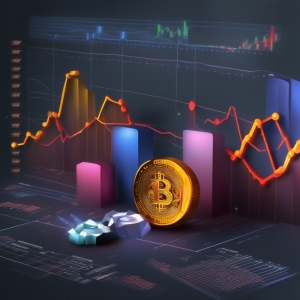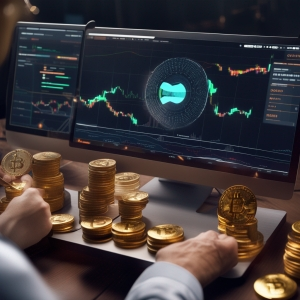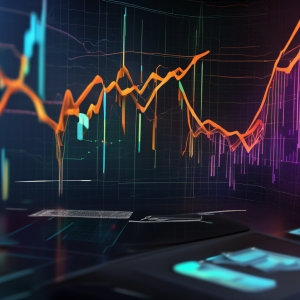Table of Contents:
Crypto Margin Trading is a tricky yet profoundly rewarding trading strategy in the world of digital currencies. Whether you're a seasoned trader or a beginner dipping your feet into the crypto waters, understanding how this strategy works can elevate your trading game to the next level. Here, we will traverse the world of margin trading in crypto, simplifying all complex concepts for everyone to grasp.
Introduction to Crypto Margin Trading
Crypto Margin Trading is a type of trade that allows you to trade more money than you have in your account. It involves borrowing money or cryptocurrency to amplify potential profits, escalating both gains and risks. Implementing margin trading can amp up profit levels due to the leveraged amount provided by the lender or exchange.
While the operation appears to be simple, the risks involved are substantial. Here, we're not just talking about losing what you have in your account, but also the borrowed amount. That's why it's paramount to understand the mechanics of margin trading before plunging into actual trading.
Clearly, while it presents the potential for exponential profits, the losses can be equally brutal, a factor that makes it a high-risk, high-reward strategy. Therefore, it isn't surprising that several successful traders swear by its potential to multiply gains, while others warn about the amplified risks involved.
In this article, we delve deeper into the realm of crypto margin trading, explain its operations, and analyze both its benefits and drawbacks. We aim to provide every crypto enthusiast with a comprehensive guide to master the art of margin trading.
Understanding the Mechanics of Margin Trading
At its core, margin trading involves borrowing funds to make trades of a larger size than your existing capital allows. So, how does it work? The process begins when a trader opens a margin account with a crypto exchange or other financial institution. This specialized account permits the user to borrow money or cryptocurrencies, employing their existing assets as collateral.
The key component of margin trading is leverage. Leverage, expressed as a ratio (such as 2:1, 3:1, or even 100:1), describes the amount a trader can borrow relative to their account balance. For instance, applying a 2:1 leverage means that for each dollar in your account, you can borrow two, effectively tripling the size of your trade.
Once a trade is placed, any profits or losses incurred will impact your account balance. Should your trades generate a profit, the borrowed funds can be returned to the lender, with the remaining profit belonging to the trader. However, on the flip side, if a trade results in losses, the trader is still obliged to repay the borrowed funds even if it means they incur heavy losses. This is the facet of margin trading that can make it extremely risky.
Additionally, crypto exchanges implement a feature known as a margin call. This is a protective measure taken when a trader's account balance drops to a predefined level, indicating that they may not be able to cover the losses incurred. The trader will either need to add more funds to their account or close their positions to repay the borrowed capital. Failure to do so could result in a forced liquidation of assets by the exchange to recover the debt.
Considerations for Margin Trading in Cryptocurrency
| Advantages | Disadvantages |
|---|---|
| Potential for High Returns | Increased Risk of Loss |
| Low Initial Capital Requirement | High Interest Rates |
| Access to More Buying Power | Potential for Loan Default |
| Flexibility in Trading Strategy | Margin Calls |
| Ability to Profit from Market Downturns | Market Volatility |
Risk and Reward: An amplifying duo in Margin Trading

The balance between risk and reward is a crucial aspect of margin trading. On the positive side, margin trading comes with the capacity to multiply trading gains exponentially. Say for instance; you initiated a $1,000 trade using 10x leverage. If the trade's value increases by 10%, your expected profit won't be just $100 (10% of $1,000), but $1,000 (10% of $10,000). These are the kind of returns margin trading can facilitate.
But Coin Report's readers who are training their guns on crypto margin trading should also keep in mind that leverage can magnify losses in the same proportion. Applying the previous scenario, if your leveraged trade takes a 10% dump instead, you don't just lose $100 but a whopping $1,000, summing unto the entire capital you initially put at stake.
Margin trading leverage also implies that you could end up owing more money than you initially invested. If invested funds are insufficient to cover the losses, you may get caught in debt. In this context, the concept of a margin call, which enforces the addition of more funds to the account or an automatic closure of positions if losses reach a certain point, comes into play.
Therefore, managing one's risk becomes an essential skill in margin trading. Keeping a vigilant eye on market trends, setting stop-loss orders, and knowing when to exit a trade can significantly mitigate potential losses.
Crypto margin trading, no doubt, provides the opportunity to generate substantially high returns on investments. However, one must approach it with prudence and a comprehensive understanding of the amplified risk-reward balance.
The Role of Cryptocurrencies in Margin Trading
In the traditional financial markets, margin trading involves dealing primarily in well-vetted and long-established stocks or commodities. However, when we shift over to the crypto realm, margin trading becomes a significantly different ball game. The primary reason being the inherent volatility, liquidity, and the youthful state of the numerous cryptocurrencies involved.
These factors can not only amplify the profits and losses as explained earlier but also introduce unique risks. For instance, given the volatility of cryptocurrencies, there can be sharper and frequent market movements. This can lead to scenarios where a trader's position is prematurely closed, or they experience a margin call lot more frequently than they would in a traditional market space.
However, it's not all doom and gloom. The volatility, along with the 24/7 open nature of cryptocurrency markets, can present unique profit opportunities. Unlike traditional markets that operate during set hours, the non-stop operation of crypto markets lends more versatility to margin traders.
Furthermore, cryptocurrency exchanges often don't require traders to go through the same stringent verification process as traditional exchanges. This means, with the proper care, knowledge, and risk management strategies, crypto margin trading might not just be a high-return game for the big players but could also cater to small players looking to make significant gains.
Leveraging Crypto Assets in Margin Trading

So far, we have understood that Crypto Margin Trading is all about leveraging your assets. Unlike traditional trading where your buying power equals your available capital, margin trading boosts this power based on the leverage ratio provided by the exchange. Let's delve into how this works when leveraging crypto assets.
Typically, you begin by depositing a fraction of the total trade value. This deposit is known as the 'margin'. Think of it as a good faith deposit that secures your position on the exchange. The exchange then provides the remaining balance. This is your borrowed capital, and it allows you to execute trades exceeding your initial capital.
The real catch in leveraging crypto assets in margin trading lies in the volatile nature of cryptocurrencies. High volatility combined with high leverage can generate significant profits from relatively small price movements. However, investors should note that the element of risk is equally inflated.
Furthermore, the margin rates (the cost of borrowing funds) can influence the overall profitability of your trades. Exchanges charge an interest rate on the borrowed amount, and it's crucial to factor these costs into your calculations to evaluate a trade's potential profitability.
On some crypto exchanges, the leverage ratio can be as high as 100:1. Extreme caution is necessary when using such high leverage ratios as any market swing could cause significant losses, especially in the highly unpredictable crypto market.
Leveraging crypto assets in margin trading will test your market acumen, trading strategies, and risk tolerance. As such, it's absolutely important to maintain your strategy and not get carried away by the idea ofhigh returns with high leverage.
Managing Risks in Crypto Margin Trading
Being a successful crypto margin trader doesn't just mean knowing how to maximize profits; it also involves a strategic approach to minimizing potential losses. This can be accomplished through diligent risk management strategies. As the saying goes, "do not put all your eggs in one basket," a principle that applies seamlessly to margin trading.
One handy tool you can use is the stop-loss order. This allows you to set a predetermined price for selling your assets if the price drops to that point, effectively limiting your losses. Additionally, take-profit orders let you set a predefined price to sell your assets at a profit, ensuring that you don't miss out on potential profits when you are away from your trading screen.
Pursuing a balanced and diversified trading portfolio can also be a good call to action. This involves spreading your capital across various assets to mitigate the risk of significant losses from a single asset. Remember, diversification does not equate to mere quantity but smartly dividing investments across assets with various risk levels and correlating the performance of different assets.
Moreover, regular monitoring of the market trends and adjustments of trading strategies accordingly is pertinent. Crypto markets are notoriously volatile, making it even more necessary to stay up-to-date with news, trends, and significant economic developments. Keeping a constant eye on your trades, setting realistic profit targets, and being ready to cut your losses when things don't go as planned can save your investments from spiralling losses.
Lastly, starting small with margin trades is advisable. Despite the temptation to gain massive profits, leveraging smaller amounts initially can help you understand market mechanisms better and decreases the potential of heavy losses. Over time, as your skills improve, you may then consider gradually increasing the size of your trades.
Conclusion: Evaluating the Potential of Crypto Margin Trading

To sum up, Crypto Margin Trading is a potent tool that, when wielded with discipline and sound understanding, can significantly elevate your trading potential. It offers the prospect of larger profits through the mechanism of leverage, which amplifies both profits and losses.
However, the inherent risks linked to margin trading can't be ignored. It isn't a strategy to be taken frivolously. Leveraged trading positions mean higher exposure to market volatility. A market move in the wrong direction can result in substantial losses and potential debt.
For beginners in cryptocurrency trading, we recommend starting slow by trading initially with just your capital, then gradually incorporating leverage when you become more comfortable with market dynamics. It's essential to use stop-loss orders, understand when to exit a trade, and manage risks prudently while using this strategy.
Remember, being wise and patient brings success in trading. Crypto Margin Trading is a potent instrument in your trading toolkit, but it must always be handled with care, comprehension, and caution.
Understanding Margin Trading in Crypto
What is margin trading in crypto?
Margin trading in crypto involves borrowing funds to increase potential returns on a trade. This can amplify gains, but also magnify losses.
How does margin trading work?
Traders borrow funds to invest more in a trade. The initial amount the trader starts with as collateral is the margin. If the trade’s value falls too much, a margin call is made, and the trader must replenish their account.
What are the benefits of margin trading in crypto?
The main benefit of margin trading in crypto is the potential for higher profits due to the increased amount of capital that can be used for a trade. However, this comes with greater risk.
What are the risks of margin trading in crypto?
The risks of margin trading include potential losses that can exceed the initial margin. If the market drops significantly, traders could lose more than their initial investment and still owe money to the lender.
Are there alternatives to margin trading in crypto?
Yes, other trading methods include spot trading (buying or selling a cryptocurrency outright) and futures trading (agreeing to buy or sell a cryptocurrency at a future price).












